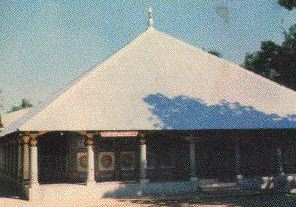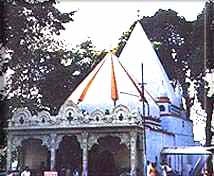
Institution of Satra :- These are unique features of Vaishnavism in Assam.. Satras are basically monasteries which were propagate neo Vaishnavism. They also became centers for education and dissemination of all kinds of art of harmonius living. Satra culture developed mainly at Majuli, Bardowa, Barpeta, Madhupur etc. When the British invaded Assam in 19th century, missionaries followed and churches were established all over Assam. Assam is a unique example of communal tolerance and religious harmony which prevails amongst the believer of different faiths. Assamese society is remarkably free from communal conflict.
Barpeta Satra and Kirtanghar :- This famous Shrine and Kirtanghar attracts Vaishanavas from all over India. It was established by Madhadeva, the greatest disciple of Shankerdeva
Satras of Majuli :- World's largest river island Majuli is the seat of several Satras established by Vaishnava revivalist, Sankardeva. During Rasotsava several thousand devotees visit these holy Satras every year.
Batadrawa Satra and Shrine :- 14 kms from Nagaon town, Batadrawa is the birthplace of famous Vaishnava reformer Sankerdeva. The shrine is held in high veneration by the Vaishnavas.

Kirtan Ghar (Barpeta Satra)

Kamakhya
Vasistha Ashram :- This Ashram is 16 kms from Guwahati and is believed to have been established by the great Sage Vasistha. It is located on the Sandhyachal hills. The ashram has a bestowing charm of its own. It is an important pilgrimage with rivulets Sandhya, Lalita and Kanta converging here.
Kamakhya and Bhubaneswari Temple :- This temple is on the top of the Nilachal hill some eight kms from Guwahati. This temple is dedicated to Shaktism and the different sculptures in the temple premises date back from eighth to seventeenth century. Devotees from all over India converge on this holy place during Ambubachi Mela and Manasha Puja.
Hayagriva-Madhab Temple :- Hajo, about 20 Kms. from Guwahati is the meeting place of Hinduism, Islam and Buddhism. It is an important pilgrimage for Hindus and Buddhists both.

Gita Mandir

Maha Bhairav Temple
Maha Bhairav Temple :- Dedicated to Lord Shiva this temple is the oldest Shiva shrine in the region. It is located in Tezpur town.
Umananda Temple :- The great Shiva temple situated on the pea-cock island in the middle of Brahamaputra in Guwahati attracts devotees from all over the country during the Shivaratri celebrations.
Poa Macca :-At Hajo itself there is this Poa Macca. It is a pilgrimage for Muslims. It is believed that by offering prayers here a faithful gains one fourth spiritual enlightenment of what could be gained at Macca.
Shivadol :- It is the tallest Shiva temple in North East India. It is located in Sibsagar. This temple is on the banks of a huge lake where thousands of migratory birds are seen during winter.
Dargah of Ajan Pir :- The dargah of Muslim saint Shah Aulia alias Ajan Fakir, who led a Muslim reform movement in Assam, is a revered place of pilgrimage for the Muslims and Hindus alike.This is in a place known as Sahaguri Chapari near Sibsagar.

Poa Macca